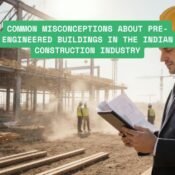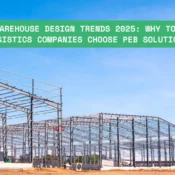
A Complete Overview of Steel Pre-Engineered Buildings
The Real Challenge of Business Expansion
In 2019, a mid-sized manufacturing company faced a critical problem. Business was booming, orders were piling up, and demand was at an all-time high. However, the production facility couldn't keep up. Traditional brick-and-mortar construction methods were proving to be time-consuming and costly, posing a real threat to the company’s competitive edge. After exploring alternatives, the business found a solution in Pre-Engineered Buildings (PEBs). The adoption of PEBs enabled them to expand their operations swiftly, minimize disruptions, and cut costs, allowing the company to meet market demands head-on.
Such stories are not isolated. They resonate with countless businesses grappling with the pressures of growth and the realities of scaling up quickly. As India’s business landscape becomes more competitive, companies are shifting toward Steel Pre-Engineered Buildings to adapt to evolving needs.
This blog explores why PEBs have emerged as a preferred solution, offering businesses a way to meet new challenges without compromising on efficiency or budget.
What Are Steel Pre-Engineered Buildings?
Steel Pre-Engineered Buildings (PEBs) are advanced construction systems where the entire design is pre-fabricated and delivered to the site for assembly. Unlike traditional construction that involves on-site work, PEBs use a modular approach. This means structural elements like columns, beams, and trusses are pre-manufactured in a controlled factory environment and then transported to the construction site for assembly.
Advantages of Modular Construction
- Precision and Quality Control: Factory-controlled production ensures a higher degree of precision, reducing the chances of on-site errors. Quality checks at every stage of production lead to enhanced durability and consistency.
- Quick Turnaround: Modular construction eliminates the lengthy, unpredictable timelines associated with traditional building techniques.
This comprehensive approach to construction has led to a paradigm shift in how industries are building warehouses, manufacturing plants, and commercial spaces. Businesses appreciate the clear cost and time advantages PEBs offer, along with the reliability of modern construction.
"At Metal Tree, we believe that building strong foundations is not just about structures, but about empowering growth and innovation. "
Why Choose Steel Pre-Engineered Buildings?
- Cost Efficiency: Beyond Initial Savings
In the traditional construction model, the costs are often riddled with unpredictability. Steel PEBs, on the other hand, offer a streamlined approach that focuses on optimizing costs at every stage. Pre-fabrication in a controlled environment reduces the risk of material wastage and damage, which are common in conventional construction sites.
For instance, an agricultural company in southern India reported saving nearly 20% on construction costs after switching to PEBs for their cold storage units. Reduced on-site work, fewer labor requirements, and minimized disruptions during bad weather contributed to these savings. These savings go beyond the initial construction phase and extend to operational costs due to lower maintenance needs.
- Speed of Construction: Time Equals Money
The efficiency of PEBs doesn’t just stem from their cost savings—it’s also about time. A traditional warehouse can take six months to a year to complete, depending on the size and complexity. In contrast, with PEBs, a similar warehouse can be erected in just a matter of weeks.
Imagine an e-commerce company that needs to expand its warehouse facilities to accommodate the surge in online shopping. Traditional construction would mean losing crucial market opportunities. However, with PEBs, they could scale up quickly and start leveraging their new facilities almost immediately.
- Flexibility and Scalability
As businesses grow, their needs change. Steel PEBs are designed to adapt to these evolving needs seamlessly. Expanding a steel PEB is a straightforward process, requiring only minor adjustments and modifications to the existing structure. This flexibility is crucial for industries where space and capacity requirements are constantly shifting.
For example, in the automotive industry, production lines and storage needs often fluctuate based on demand. PEBs provide the necessary adaptability to expand or reconfigure spaces without compromising on quality or safety.
- Durability and Low Maintenance
Steel’s natural durability makes it ideal for PEB construction. High-quality steel can withstand harsh weather conditions, seismic activities, and heavy loads. Many PEBs also come with protective coatings that further prevent corrosion and rust, especially in coastal areas prone to salty air.
A case in point is a logistics company in Maharashtra that faced frequent maintenance issues with its traditional buildings. After switching to steel PEBs, their maintenance costs dropped significantly, and they experienced fewer disruptions due to structural issues.
Key Industries Benefiting from Steel PEBs
- Manufacturing and Production Units
Manufacturing plants often require large open spaces, high load-bearing capacity, and the flexibility to incorporate heavy machinery. PEBs offer the ideal solution with their robust design and customizable features. For instance, factories can incorporate overhead cranes, multi-level mezzanines, and wide spans without internal columns that hinder workflow.
- Logistics and Warehousing
With the rapid rise of e-commerce in India, warehousing has become a key concern for logistics providers. Steel PEBs offer cost-effective and scalable solutions for storage, distribution, and fulfillment centers. Additionally, PEBs enable faster construction and better utilization of space through the inclusion of mezzanines and high ceilings.
- Agriculture and Food Processing
The agricultural sector is increasingly embracing PEBs for storage facilities, cold storage units, and processing plants. The benefits of quick construction, weather resistance, and low maintenance make PEBs a practical choice for rural and semi-urban settings where traditional construction may be less viable.
- Commercial Spaces
PEBs are also gaining popularity in the commercial sector. From retail spaces to office complexes, businesses are utilizing steel PEBs to create modern, aesthetically pleasing buildings that reflect their brand identities.
The Sustainability Advantage of Steel PEBs
- Eco-Friendly Materials and Design
PEBs are inherently eco-friendly due to the use of recyclable steel. Additionally, PEB fabrication processes generate minimal waste, as precise designs reduce the need for excess material. Leftover steel can be melted down and reused, contributing to a circular economy.
- Energy Efficiency and Lower Operating Costs
Design elements such as skylights, insulated panels, and efficient ventilation systems allow PEBs to offer energy savings. These buildings can be optimized to reduce the need for artificial lighting and extensive HVAC systems, lowering energy bills and reducing the carbon footprint.
- Achieving LEED Certification
For businesses aiming to obtain LEED certifications, PEBs provide a strong foundation. These buildings meet several criteria required for LEED certification, such as energy efficiency, use of recycled materials, and sustainable site planning. Achieving such certifications adds value to the company’s brand image and aligns with long-term sustainability goals.
Customization and Aesthetics
Gone are the days when steel structures meant drab, uninspired buildings. Today’s PEBs offer extensive customization options, allowing businesses to create visually appealing and functional spaces. Companies can choose from a range of design options, including color schemes, facades, and architectural features.
For example, a retail brand can customize its storefront with glass facades, vibrant cladding, and sleek architectural features. Similarly, office buildings can incorporate open floor plans, stylish interiors, and modern amenities, all within a PEB framework.
Addressing Common Misconceptions and Challenges
Misconception 1: PEBs Are Only for Temporary Structures
This notion is outdated. Modern PEBs are designed for long-term use and are being adopted for permanent infrastructure projects in various sectors. The use of high-grade materials and precise engineering ensures the longevity of these structures.
Misconception 2: Limited Customization Options
The idea that PEBs offer limited customization is a myth. With advancements in computer-aided design and engineering, PEBs can be customized to meet specific requirements, whether it’s adding mezzanines, creating unique facades, or integrating technology.
Overcoming Challenges
Adopting PEBs may require a shift in mindset, particularly in traditional industries. However, as awareness about the benefits of PEBs grows, businesses are increasingly making the switch and reaping the rewards.
The Future of Steel Pre-Engineered Buildings in India
India’s infrastructure landscape is undergoing a transformation, and steel PEBs are at the forefront of this change. Several factors are driving this shift:
- Government Initiatives and Support
Initiatives like “Make in India” are focusing on boosting infrastructure development. Steel PEBs offer an ideal solution to meet the growing demand for industrial, commercial, and institutional spaces. The government’s push for faster, sustainable construction practices aligns perfectly with the benefits offered by PEBs.
- Urbanization and Growing Market Needs
As cities expand and industries relocate, there’s an increasing demand for flexible and scalable infrastructure. Steel PEBs provide a practical solution, enabling businesses to build quickly and adapt to changing market conditions.
- Technological Advancements
The integration of digital tools and smart technologies into PEB design and manufacturing is streamlining the construction process. With the help of Building Information Modeling (BIM) and advanced design software, businesses can now visualize and plan their PEB projects with greater accuracy, reducing errors and improving efficiency.
Conclusion: Embrace the Future with Steel PEBs
In today’s competitive business environment, the ability to scale quickly and cost-effectively is crucial. Steel Pre-Engineered Buildings provide these advantages and more, making them the preferred choice for companies aiming to stay ahead of the curve. Whether you are expanding a logistics hub, modernizing a manufacturing unit, or setting up a new commercial space, Steel Pre-Engineered Buildings offer the versatility, durability, and sustainability that businesses need.
Companies like Metal Tree are at the forefront of this revolution, providing high-quality, customizable steel PEBs that cater to India’s growing infrastructure demands. With a keen understanding of the market and a commitment to quality, Metal Tree is helping businesses embrace a smarter and faster way to build.
If your business is on the path to growth, it’s time to adopt a construction solution that matches your ambition. Steel Pre-Engineered Buildings are not just an alternative—they are the future of infrastructure. Start your journey with Metal Tree and experience the benefits of modern construction done right.
One thought on “A Complete Overview of Steel Pre-Engineered Buildings”
Add a Comment Cancel reply
All Categories
Recent Posts
How Much Does a Pre-Engineered Building Cost in India? Ultimate Price Guide
Tags
Call Us at
+91 9311624628





[…] All along, conventional techniques used for industrial construction required intricate procedures, consumed plenty of time, and cost a fortune. With the evolving demands of the modern industrial sector, there’s been a strong shift towards adopting innovative and more efficient solutions. Enter pre-engineered steel buildings (PEBs). […]